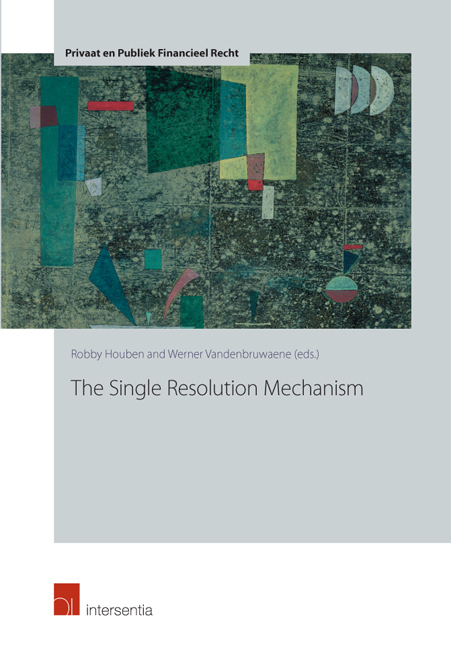Book contents
- Frontmatter
- Preface
- Contents
- Introduction: Recovery and Resolution, Future Solutions for Dealing with Insolvency
- The Single Resolution Mechanism. Institutional and Financing Arrangements for Bank Resolution in the European Banking Union
- Resolution from the Belgian Resolution Authority's Perspective
- Judicial Protection in the Single Resolution Mechanism
- The Rules on State Aid and the Framework for Bank Resolution: Foreplay and Interplay
- Concluding Remarks on Resolution and Resolvability Challenges
Resolution from the Belgian Resolution Authority's Perspective
Published online by Cambridge University Press: 25 September 2018
- Frontmatter
- Preface
- Contents
- Introduction: Recovery and Resolution, Future Solutions for Dealing with Insolvency
- The Single Resolution Mechanism. Institutional and Financing Arrangements for Bank Resolution in the European Banking Union
- Resolution from the Belgian Resolution Authority's Perspective
- Judicial Protection in the Single Resolution Mechanism
- The Rules on State Aid and the Framework for Bank Resolution: Foreplay and Interplay
- Concluding Remarks on Resolution and Resolvability Challenges
Summary
INTRODUCTION
Almost 10 years ago, the financial landscape was shaken up by a financial crisis. The global financial crisis of 2007–2008 resulted in massive losses for many large credit institutions and equally massive government bail-outs. In many European countries, total government funding for bank bail-outs amounted to double-digit proportions of GDP, reaching fifty percent or higher in certain countries. While a number of inadequacies in micro-prudential and macro-prudential regulation were identified as having contributed to the causes of the crisis, the absence of appropriate insolvency frameworks for financial institutions was one of the key explanations for the belief on the part of many governments that they had no choice but to bail out the credit institutions that were hit by the crisis. Inconsistencies across countries in supervisory powers and in the legal frameworks for insolvent financial institutions also posed serious obstacles to the treatment of insolvent cross-border banking groups.
As a result, new regulations that aimed at improving crisis management frameworks for financial institutions have been passed in many countries. These frameworks are based on the Key Attributes of Effective Resolution Regimes for Financial Institutions published by the Financial Stability Board (FSB) in 2011 and include special provisions that should be seen as an alternative to insolvency proceedings. These new rules are commonly referred to as resolution procedures. In Europe, the Bank Recovery and Resolution Directive (BRRD) aims at establishing an effective framework for crisis preparation and crisis management that is harmonised across all European Member States for credit institutions and for some investment firms (hereinafter referred to as “institutions”) and financial groups.
The framework created by the BRRD consists of five main parts: (1) preparation and prevention; (2) early intervention; (3) resolution powers and tools; (4) funding of resolution and (5) cooperation between authorities. Crisis preparation and prevention involves the drafting of recovery and resolution plans for institutions and groups, as well as assessments by resolution authorities of the resolvability of institutions and groups. The BRRD's early intervention component aims to provide supervisory authorities with appropriate responsibilities and powers in ensuring that the financial difficulties faced by institutions are addressed as soon as they arise.
- Type
- Chapter
- Information
- The Single Resolution Mechanism , pp. 49 - 76Publisher: IntersentiaPrint publication year: 2017

